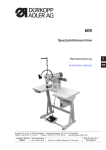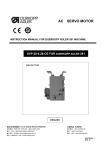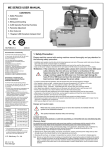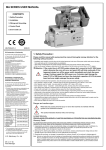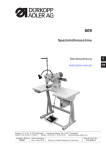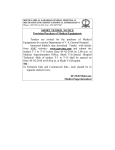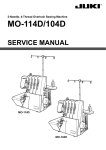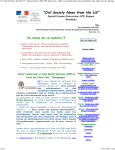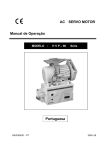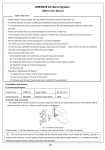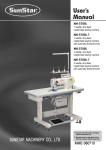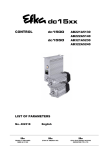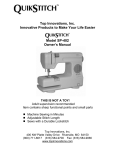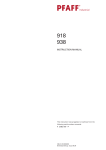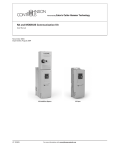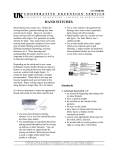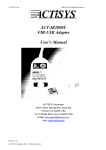Download MOTOR PMX
Transcript
Operation Panel Operation Instruction Manual 第 1 页 共 22 页 1. Operation Panel Overview Operation panel (as shown in fig. 1-1), the front surface is divided into two parts: LED Display Area and Push-button Area. And on upper right of operation panel, there is a thumb wheel which is available to be turned C.W and C.C.W. Fig. 1-1 The LED Display Area is on upper-center of the operation panel. The functional parameter display is made up for 6 LEDs. There is a push-button on each side of display area; they are the “Function Key”, “Cycle Key”. Under the display area, there are 12 push-buttons, with LED on upper right or left to show whether the function is on or off. Fig. 1-2 Detailed description of each push-button is shown in table-1. Table 1: Push-button description of operation panel No. Sign 1 2 Description Function Key: Main function is to confirm operation and also can be used with other buttons for key-combinations; Cycle Key: Change parameter position when configuration; Front-end Back tacking Key: Cycle selection among the single, double, 3 quadruple and none front-end back tacking. After selection, different combinations of upper left and right LEDs will show the current status; 4 Rear-end Back tacking Key: Cycle selection among the single, double, quadruple and none rear-end back tacking. After selection, different 第 2 页 共 22 页 combinations of upper left and right LEDs will show the current status; Free-sewing Mode Key: After this mode is selected, LED on upper left will be 5 lighted; Multi-section Sewing key: After this mode is selected, LED on upper left will be 6 lighted; W-type Sewing Key: Select W-type sewing mode. After selection, the upper left 7 LED will be lighted; Soft-start Key: Select soft-start mode. After selection, the upper left LED will be 8 lighted; Foot Lifting Key: Automatic foot lifting setting. Select foot lifting and mid-foot 9 lifting functions. After selection, upper left and upper right LED combination will show the current status; Trimming Key: Select/not select auto trimming. After selection, the upper left 10 LED will be lighted; Trigger Key: Select/not select trigger mode. After selection, the upper left LED 11 will be lighted; Needle Stop Position Key: Select up/down needle position. After the up needle 12 position is selected, the upper left LED will be lighted; Sewing Lamp Key: Select on/off the illumination lamp. After lamp on is 13 selected, the upper left LED will be lighted; Stitch Compensation Key: Compensation function is on when you press the key, the function will be off when you release it. After compensation function is 14 selected, the upper left LED will be lighted; 2. User Mode Definition 2.1 Operator Mode This mode is the default mode of operation panel; operation panel will enter this mode automatically after switched on. After entering this mode, the 6 decimal points of LED will move in couples (display likes ), this means HMI is in idle condition. When doing any operation, if you don’t press any button or turn thumb wheel for a long time, HMI will switch to idle mode automatically and the previous operation will not be executed! 第 3 页 共 22 页 2.1.1 Sewing Mode Set Up: Free Sewing Mode: Press press , LED displays , then if you to confirm operation, LED display will recover to idle condition and upper left LED of will be lighted. , LED displays Multi-section Sewing Mode: Press , this is the operation interface of multi-section sewing. You can use the thumb wheel to confirm N sewing sections according to your need, then press parameters and quit the interface, or press , to confirm , LED displays , entering the interface of stitch number set-up for each section. In this interface, you can to choose the section which should be changed, then use thumb wheel to use change stitch number, after operation is done, press to confirm the parameters and quit the interface, then LED display will recover to idle condition. So long as the multi-section sewing mode is on, upper left LED of W-type Sewing Mode: displays Press , enter will be lighted. W-type sewing function, , this is W-type sewing interface. You can use LED to switch over A, B, D section, and use thumb wheel to change stitch number of each section. After confirmation, press , then LED display will recover to idle condition, and upper left LED of will be lighted. 2.1.2 Front-end/Rear-end Back tacking Setting: When mode. press When press double or , LED enters front-end or rear-end back tacking setup , LED cycles among the single , quadruple front-end back tacking interfaces. When press , , and none , LED cycles among the single, to double, quadruple and none rear-end back tacking (fig. omitted). You can press switch section A, B or C, D, and use thumb wheel to change stitch number of each section. After changing, press to confirm operation, LED display will recover to idle 第 4 页 共 22 页 condition. The two LEDs on front-end or rear-end back tacking key will be lighted to show corresponding conditions. are both off, means none back tacking; When 2 LEDs on When upper left LED on tacking; is on, upper right is off, means single back When upper left LED on tacking; is off, upper right is on, means double back are both on, means quadruple back tacking. When 2 LEDS on Note: above instruction we provide pictures of front-end back tacking 2.1.3 Soft-start Set Up: press to select soft-start function, after selection, LED on upper left of be lighted. Press again can quit soft-start condition; LED on upper left of will will be off. 2.1.4 Foot Lifting Set Up: Use to choose foot lifting mode, there are four different modes: auto-foot-lifting; , means auto-foot-lifting after trimming; when stop during sewing; , means no , means auto-foot-lifting , means auto-foot-lifting after trimming and stop during sewing. Use to cycle select among these four modes, after selection the LEDs will also show in corresponding conditions. 2.1.5 Trimming Set Up: Use : to choose auto-trimming mode. When it’s auto-trimming, upper left LED of will be lighted; when auto-trimming is off, upper left LED of 2.1.6 Trigger Set Up: Use will be off. : to choose trigger mode. When it’s in trigger mode, upper left LED of will be lighted; when trigger mode is off, upper left LED of will be off. 2.1.7 Needle Position Position Set Up: Use to choose up/down needle position. When down position is selected, upper left LED of be off. will be lighted; when up position is selected, upper left LED of 2.1.8 Sewing Lamp Set Up: Use to turn on/off sewing lamp. When turn on the lamp, upper left LED of is on; when turn off the lamp, upper left LED of 2.1.9 Stitch Compensation Set Up: will be off. 第 5 页 共 22 页 will Use to activate stitch compensation function, when you release the button, the will be function will be deactivated. When the function is selected, upper left LED of lighted, otherwise the LED of will be off. 2.2 Technician Mode When HMI is in idle condition, press interface, LED displays first, then press to enter technician . Then use thumb wheel to change value directly in the digit position with the flashing decimal point, you can use to change position of the flashing decimal point. After confirmation, press . If you don’t press any button or turn thumb wheel within the certain time, HMI will recover to idle condition automatically. 2:Parameter List of Technician Mode Para. Para. Para. Default Value Type max min Value Range 0 200 Remark 100 Start sewing speed ~800 200 1 Max. speed of free sewing mode(Max. speed limitation 2500 ~3000 of overall situation) 200 2 2500 Max. speed of fixed-length sewing ~3000 200 3 2500 Max. speed limitation of manual backstitch ~3000 Speed 0 Para. 100 4 200 Stitch compensation speed ~800 100 5 250 Trimming speed ~500 6 0 0 /1 Slow-start mode:0; slow-start only after trimming,1:after trimming, sewing stop, both has slow-start 7 2 8 200 1 ~9 Slow-start stitch number 100 Slow-start speed ~800 第 6 页 共 22 页 Para. Para. Para. Default Value Type max min Value Range Remark System acceleration sensitivity(for direct drive, the value can be bigger; for belt drive, don’t use big value, which 9 20 1 ~20 will make more vibration and noise. This Para. Will not affect motor torque) System deceleration sensitivity (for direct drive, the value can be bigger; for belt drive, don’t use big value, which A 20 1 ~20 will make more vibration and noise. This Para. Will not affect motor torque) 200~120 B 800 Medium speed value(RPM) 0 C 50 0 800 25~200 Low speed value(RPM) 200 Front-end back tacking speed ~2200 200 1 800 Rear-end back tacking speed ~2200 200 2 800 tacking W-type sewing speed ~2200 Back 1 Para. 3 26 0 ~70 Front-end back tacking, No.1 stitch compensation profile 4 37 0 ~70 Front-end back tacking, No.2 stitch compensation profile 5 26 0 ~70 Rear-end back tacking, No.1 stitch compensation profile 6 37 0 ~70 Rear-end back tacking, No.2 stitch compensation profile 9 200 1~999 A 180 10~359 Auto back tacking section stop time CT(ms) Stitch compensation reference angle(optimum actuation angle of backstitch electromagnet) Start back-tacking mode selection: 0;One shot sewing Back 1;Pedal control and motor can stop at middle way. tacking 2 0 0 0/1/2/3 2;One shot sewing but motor stops at needle up by CT Mode timer at end of each seam. 3;One shot sewing but motor stops at needle down by 第 7 页 共 22 页 Para. Para. Para. Default Value Type max min Value Range Remark CT timer at end of each seam. At the end of Start back-tacking mode selection. 0;At the end of Start back-tacking ,machine continues sewing if pedal pressed or START signal on (standing operation) 1 0 0/1/2 1;At the end of Start Back-Tacking, machine stops and must re-start by pedal command. 2;Making the trimming cycle once the Start Back-Tacking finished. ( Mini Bar tacking ) Automatic sewing End mode selection 2 0 0/1 0;Start back-tacking 1;Active when motor stop,Invalid. End back-taking mode selection. 0;One shot sewing 1;Invalid 3 0 0/1/2/3 2;One shot sewing but motor stops at needle up by CT timer at end of each seam. 3;One shot sewing but motor stops at needle down by CT timer at end of each seam. Bar-tacking mode selection. 0;One shot sewing 1;Pedal control and motor can stop at middle way. 4 0 0/1/2/3 2;One shot sewing but motor stops at needle up by CT timer at end of each seam. 3;One shot sewing but motor stops at needle down by CT timer at end of each seam. 5 0 0 ~99 Setting stitches C of End 6 0 0 ~99 stitches plus on Start back-tacking 7 0 0 ~99 stitches plus on End back-tacking 8 0 0 ~3 frequence of middle fixed length back tacking 第 8 页 共 22 页 back-tacking Para. Para. Para. Default Value Type max min Value Range 9 0 0 ~99 Remark needle number of middle backing tacking Pedal speed-control profile mode: 0:Auto linear ramp(auto calculation according to max. speed) Speed Pedal value 1:Two-stage ramp (can be set up freely, use Para. No.31 and No.32) Speed Pedal 0 /1 / 2 / 3 Para. 0 2 Pedal value 3 2:Power law curve(use No.33) Speed Pedal value Pedal 3:S-type curve(first slow then quick, better operation in low speed) Speed Pedal value 第 9 页 共 22 页 Para. Para. Para. Default Value Type max min Value Range Remark Sub-para. Of two-stage speed control: mid-turning-point speed RPM (two-stage ramp turning point speed), only valid when para. No.30’s value is 1. Pedal 200 3 1 3000 Para. Speed ~4000 Mid-turning Pedal -point speed Sub-para. Of two-stage speed control ramp: Pedal analog value of mid-turning-point, valid when Para. No.30 is set to 1, the para. Value should be in the range from para. No.38 to para. No.39. 800 0 ~1024 2 Speed Mid-turning-point Analog Value Pedal Value Pedal Para. Sub-para. Of power speed control curve: 3 Valid when para. No.30 is 2. 1: Square(slow first, faster later, easy to control in low speed); Speed 3 2 1 /2 Pedal Value 2:Radication(fast first, slower later, response fast); Speed Pedal value 第 10 页 共 22 页 Para. Para. Para. Default Value Type max min Value Range 4 150 0 ~1024 Remark Trimming pedal-position set up, see fig. 2-1 (setting value should no bigger than Para. No.35) Foot lifting pedal-position set up, see fig.2-1 5 300 0 ~1024 (Setting value should be in the range of para.No.34 and para. No.36) Pedal mid-homing position, see fig. 2-1. 6 460 0 ~1024 (Setting value should be in the range of para. No.35 and para. No.37) Pedal forward running position, see fig. 2-1. 7 480 0 ~1024 (Setting value should be in the range of para.No.36 and para. No.38) Pedal low speed running position (upper limitation), see fig. 2-1. 8 680 0 ~1024 (Setting value should be in the range of para.No.37 and para. No.39) Pedal max. Analog value, see fig. 2-1. 9 960 0 ~1024 (Setting value should be no less than para.No.38) A 0 0 ~800 Pedal foot lifting confirming time After pedal back to homing position then trimming selection start: B 0 0/1 0:off 1:on Foot lifting position, foot lifting function selection: C 1 0/1 0: without 1:with Trimming position, foot lifting function selection: D 1 0/1 0: without 1:with Auto upper needle stop position search after switch on: 0 1 0/1 0: function on 1: function off 第 11 页 共 22 页 Para. Para. Para. Default Value Type max min Value Range Remark Auto back tacking function selection: (for machines without this function, we suggest to 1 Customize 1 0/1 4 deactivated this function Set up 0: function off 1:function on Function mode selection when manually push back tacking 2 0 0/1 0:Juki mode. During sewing or stop sewing both have this action. 1:Brother mode. Only acts during sewing. Special operation mode: 0: Operator selection 1: Simply sewing mode 0/1/ 3 0 2: Motor initial angle measurement (not necessary to 2/3 remove the belt) 3: Ratio mode calculation (synchronize encoder is necessary and belt can not be removed) Motor torque increase function in low speed on & off: 4 0 0—31 0: Normal functions 1-31: low speed torque increase level Needle stop mode: 0: Constant speed idle mode (in belt drive mode, stop 5 1 0/1 accuracy is not high) 1: Pull-back mode (PMX mode) 6 100 0 ~800 Instruction execution time of half stitch compensation 7 150 0 ~800 Instruction execution time of one stitch compensation 0/1/ Needle compensate:0.press time to 8 0 2 Count 5 control;1.half needle;2.one whole needle 9 0 Running-Delay time setting after foot lift A 0 0~10 The larger the value the faster to up speed 0 1 1~ Stitch counting proportion set up 第 12 页 共 22 页 Para. Para. Para. Default Value Type max min Value Range Remark Mode 100 1~ 1 1 Stitch counting value set up 9999 Stitch counting mode selection: 0: no counting 1: Counting up according to stitch number, after reaching set value then restart. 2: Counting down according to stitch number, after reaching set value then restart. 3: Counting up according to stitch number, after reaching 2 0 0~4 set value, then motor should stop automatically, recounting should be restart by S4 [152.INI] =CRS or the button A on operation panel. 4: Counting down according to stitch number, after reaching set value, motor should stop automatically, recounting should be restart by S4 [152.INI] =CRS or the button A on operation panel. 1~ 3 1 Trimming counting proportion set up 100 1~ 4 1 Trimming counting value set up 9999 Trimming counting mode selection: 0: no counting 1: Counting up according to stitch number, after reaching set value then restart. 5 0 0~4 2: Counting down according to stitch number, after reaching set value then restart. 3: Counting up according to stitch number, after reaching set value, then motor should stop automatically, recounting should be restart by S4 [152.INI] =CRS or the 第 13 页 共 22 页 Para. Para. Para. Default Value Type max min Value Range Remark button A on operation panel. 4: Counting down according to stitch number, after reaching set value, motor should stop automatically, recounting should be restart by S4 [152.INI] =CRS or the button A on operation panel. 0 0 0 Running time reset Para. transmission method: 0: no action; 1 0 0/1/2 Operatio n 1: Para. Download (from operation panel to controller); 6 2: Para. Upload (from controller to operation panel). 2 2000 1, 2, 88 3 0 1, 2 Recover to default para. Save current para. As User custom para.(recoverable) Note: operation para. Of (6X) will not be save. 图 2-1 踏板动作参数各位置示意图 2.3 Administrator Mode When displays HMI in idle mode, first press , then press , to enter administrator use thumb wheel to change value with the flashing radix point, and change flashing point position. After the value is confirmed, you can switch to next para. Or press interface, can be used to to confirm modification. If you don’t press any button or turn thumb wheel in a certain time, system will automatically switch to HMI idle condition. Table 3: Para. List of Administrator mode 第 14 页 共 22 页 LED Para. Para. No. Para. No. Defaul Type max min t Value Value Range Remark Motor running mode at trimming sequence 0: For general Lock-Stitch 0 0 0/1 machines . 1:For general Cover stitch machines with under trimmer only. Mech. Angle when trimming 1 0 0~359 finished Trimming time sequence selection: 0: [TS] set angle start trimming, until upper needle stop position is reached, then time delay to [T2] set value. Trimming Mode 0 1: [TS] set angle start trimming, until [TE] set angle. 2: [TS] set angle start trimming, time delay to [T2] 0/1/2/3/4 2 1 set value. /5/6 3: After lower needle stop position is reached, time delay to [T1] set value then start trimming, time delay to [T2] set value. 4: After upper needle stop position is reached, time delay to [T1] set value then start trimming, time delay to [T2] set value, most applications 第 15 页 共 22 页 Para. Para. No. Para. No. Defaul Type max min t Value Value Range Remark are for interlock machines. 5: After lower needle stop position is reached then start trimming until to the upper position. Time delay to T1 set value then start T2 set trimming time. (Most applications are for flat sewing machines, and set value for T1 and T2 are mostly 0) 6: [TS] set angle start trimming until upper needle stop position. Time delay to T1 set value then start T2 set trimming time. Trimming start angle TS 3 10 5-359 (relate to lower needle stop position angle) Trimming finish angle TE (relate to lower needle stop 4 300 10-359 position angle, the value should be bigger than TS) 第 16 页 共 22 页 Para. Para. No. Para. No. Defaul Type max min t Value 5 10 1-999 6 60 1-999 7 30 1~999 Value Range Remark Trimming start time delay T1 (ms) Trimming finish time delay T2 (ms) Lower needle stop position trimming time delay D1 Lower needle stop position 8 90 1~9999 trimming duration time D2 Lower needle stop position 9 120 1~999 trimming recover time D3 Trimming torque increase A 20 10-70 angle (Reserved) trimming for short thread(0:off; other B 0 0~999 number:delay the closed time after finished one needle) Thread slack electromagnet time sequence selection: 0: [LS] set angle is reached start thread slack, until upper needle stop position then time Thread delay to [L2] set value. slack/Thread 0/1/2/3/4 1 0 0 sweeping/String 1: [LS] set angle is reached /5/6 start thread slack, until [LE] nipping Mode set angle. 2: [LS] set angle is reached start thread slack, time delay to [L2] set time. 3: Lower needle stop position 第 17 页 共 22 页 Para. Para. No. Para. No. Defaul Type max min t Value Value Range Remark is reached, time delay [L1] set time then start thread slack, until [L2] set time. 4: Upper needle stop position is reached, time delay [L1] set time then start thread slack, until [L2] set time. 5: Lower needle stop position is reached then start thread slack until upper needle stop position. Time delay [L1] set time then start [L2] set thread lack time. 6: [LS] set angle is reached then start thread slack until upper needle stop position. And then time delay [L1] set time, then [L2] set thread lack time. Thread slack electromagnet 1 30 5-359 start angle LS (relate to lower needle stop position angle) Thread slack electromagnet finish angle LE (relate to 2 300 10-359 lower needle stop position, the value should bigger than LS) Thread slack electromagnet 3 1 1-999 start time delay T1(ms) Thread slack electromagnet 4 10 第 18 页 共 22 页 1~999 time delay T2(ms)after upper Para. Para. No. Para. No. Defaul Type max min t Value Value Range Remark needle stop position is reached String sweeping function 5 1 0/1 selection 0: off 1:on Thread wiping/Thread 6 10 1~999 sweeping time delay ms Thread wiping/Thread 7 30 1~9999 sweeping time delay ms Thread wiping/Thread 8 50 1~999 sweeping recover time ms Thread nipping function 9 1 0/1 selection 0: off 1: on A 100 10-359 Thread nipping initial angle B 190 11-359 Thread nipping finish angle C 0 0~9999 Air blow start time delay ms D 50 1~9999 Air blow duration time ms E 160 11-359 Lower angle after foot lifting when thread nipping the angle of presser foot F 160 11~359 lifting then drop down when thread clamping Stop 0 360 200~360 position after trimming(can implement pull back function after trimming) Reverse angle before sewing Stop Mode 2 1 0 0~240 start(enhance the ability over thick material) D axis current lock selection 2 0 0/1 after stop 第 19 页 共 22 页 Para. Para. No. Para. No. Defaul Type max min t Value 3 300 Value Range Remark D axis current lock duration 1~3000 after stop (ms) Emergency Stop Mode: 0: Turn off the emergency stop function 1: Emergency stop at any 4 0 0/1/2/3 position 2: Emergency stop at upper needle stop position 3: Emergency stop at lower needle stop position Continue stitch No. before emergency stop (according to 5 0 0~999 different set speed and stitch No., the actual value might be bigger) Restart after emergency stop: 0: Can not be restart, it’s 6 0 0/1 necessary to restart the power. 1: When the alarm is canceled, can be restarted. Upper needle stop position 7 360 200~360 adjustment when machine stop Needle cooling output power 8 0 0/1/2 set up 9 2500 1 - 2550 ms Needle cooling time delay A 200 200 - 6000 rpm Needle cooling start speed B 2 1~5 stitch of double needle automatic angle 第 20 页 共 22 页 Para. Para. No. Para. No. Defaul Type max min t Value Value Range Remark Middle presser foot mode: 0: not associated with presser foot、 C 0 0/1 backtacking and alternating quantity ; 1:associated with presser foot、 backtacking and alternating quantity Foot lifting control mode 0: Push button jog switch: 0 0 0/1 1: Valid when button is pushed; Auto test mode selection: 1 0 0/1 0: With certain stitch number 1: With certain time Safety alarm confirming time ms (for flat sewing machine Mode Selection 3 safety tilting switch and 2 300 0~1000 overlock sewing machine safety knife protection switch are same, use the same solution) Safety switch recover confirm 3 50 0~1000 time ms Motor resolving direction: 4 0 0/1 1: C.C.W 0: C.W. 5 0 第 21 页 共 22 页 0/1 /2 Foot lifting signal speed Para. Para. No. Para. No. Defaul Type max min t Value Value Range Remark control function: 0: off 1: analog signal 2: digital signal 6 0 0~1023 Signal min. 7 710 0~1023 Signal max. 8 200 200~800 Signal speed control min. 9 400 200~2500 Signal speed control max. Single side detector operation mode: 0: no use of detector 1: detector on when manual start mode A 0 0/1/2/3 2: detector on when auto start mode 3: detector on when double trimming manual speed control mode Auto start mode confirming B 50 10~3000 time ms Stitch No. without response C 3 0~999 after start Stitch No. for first double D 3 0~999 trimming Continue stitch No. after signal invalid (according to E 3 0~999 different speed and stitch No., the actual value might be bigger) 第 22 页 共 22 页 Para. Para. No. Para. No. Defaul Type max min t Value Value Range Remark Air-tight joint mode of auto back tacking 0: Hold current air-tight joint F 0 0/1 condition when auto back tacking; 1: Forced close air-tight joint when auto back tacking; Motor/machine ratio:0.001 (If ratio has been calculated 0 1000 0~9999 automatically, the para. In the controller might be different with HMI) Max. 1 3500 speed limitation of 0~5000 machine Adjustment angle of upper needle stop position (relate to 2 0 0~359 angle difference of upper needle stop position encoder) Machine Para. 4 Mech. Angle of lower needle 3 175 0~359 stop position Foot lifting release time delay 4 200 0~800 (ms) Torque increase initial angle of 5 9 0~359 over thick material Torque increase finish angle of 6 57 0~359 over thick material Oil refill time alarm (hour. 0: 7 0 0~2000 function deactivated) Oil alarm, stop operation time 8 0 0~4000 (hour. 0: function deactivated) 第 23 页 共 22 页 Para. Para. No. Para. No. Defaul Type max min t Value 9 1000 200~2500 Machine signal B2 speed A 1500 200~2500 Machine signal B3 speed B 800 0~1023 Value Range Remark No.1 Analog signal input signal input threshold value No.2 C 800 Analog 0~1023 threshold value 0 1 0:Disable 1 1 1:Manual back 2 0 3 0 4 5 10 1 tacking 2:Safety switch 3:Emergency stop 4:Material side No.1 input definition No.1 active input level 0/1 No.2 input definition No.2 active input level 0/1 No.3 input definition No.3 active input level 0/1 detection 6 0 No.4 input definition 5:Pedal trimming 7 0 No.4 active input level 0/1 input 8 6:Pedal 9 No.5 input definition foot lifting input 9 1 No.5 active input level 0/1 7:Stitch compensation Input Definition 5 A 0 B 0 C 11 9:Presser foot D 1 alternation lifting No.7 active input level 0/1 E 7 10:Air-tight joint No.8 input definition No.6 input definition 8:Front-end/rear-end back tacking reverse No.6 active input level 0/1 No.7 input definition 11:Counter reset 12:OP input 13:Presser foot alternation input 1 F 1 No.8 active input level 0/1 14:Presser foot alternation input 2 15:Needle lifting lock 16:Edge joint presser 第 24 页 共 22 页 Para. Para. No. Para. No. Defaul Type max min t Value Value Range Remark foot control input17; double turn left 18: double needle turn right 0:Output disable 0 1:Trimming 2:Thread wiping 1 2 No.2 electromagnet 4 definition 4:Foot lifting No.3 5:Thread slack 0 7:Air sucking 0 9:Needle cooling 10: Presser foot 5 output definition 3:Back stitch 8:Air blowing 4 electromagnet output 3 6:Thread nipping 3 No.1 1 13 alternation lifting electromagnet output definition No.4 electromagnet output definition No.5 electromagnet output definition No.6 electromagnet output definition 11: Air-tight joint No.7 6 Output 14 electromagnet output 12:Back tacking definition 6 Definition reverse hanging mode 13:Alternation lifting mode 14:Air-tight joint mode 15:OP output 16:Bottom thread 7 8 counter full condition 17:Trimming short thread head output 18: Edge joint presser foot control output 19: double needle left needle bar actuation;20: 第 25 页 共 22 页 No.8 electromagnet definition output Para. Para. No. Para. No. Defaul Type max min t Value Value Range Remark double needle right needle bar actuation;21:double needle keep left;22: double needle keep right; No.1 0 50 electromagnet fully 1~500 output time ms No.1 electromagnet chopping 1 1 1~10 on time ms(Reserved) No.1 electromagnet chopping 2 1 1~10 off time ms(Reserved) No.1 electromagnet protection 3 0 0~600 time 100ms No.2 4 70 electromagnet fully 1~500 output time ms No.2 electromagnet chopping 5 1 1~10 on time ms(Reserved) No.1 No.2 electromagnet chopping 7 6 1 1~10 Electromagnet off time ms(Reserved) No.2 electromagnet protection 7 0 0~600 time 100ms No.3 8 150 electromagnet fully 1~500 output time ms No.3 electromagnet chopping 9 1 1~10 on time ms(Reserved) No.3 electromagnet chopping A 1 1~10 off time ms(Reserved) No.3 electromagnet protection B 0 0~600 time 100ms No.4 C 100 electromagnet 1~500 output time ms 第 26 页 共 22 页 fully Para. Para. No. Para. No. Defaul Type max min t Value D 1 Value Range Remark No.4 electromagnet chopping 1~10 on time ms(Reserved) No.4 electromagnet chopping E 1 1~10 off time ms(Reserved) No.4 electromagnet protection F 0 0~600 time 100ms No.5 0 40 electromagnet fully 1~500 output time ms No.5 electromagnet chopping 1 0 1~10 on time ms(Reserved) No.5 electromagnet chopping 2 0 1~10 off time ms(Reserved) No.5 electromagnet protection 3 0 0~600 time 100ms No.6 4 100 electromagnet fully 1~500 output time ms No.6 electromagnet chopping 5 0 1~10 No.2 on time ms(Reserved) 8 Electromagnet No.6 electromagnet chopping 6 0 1~10 off time ms(Reserved) No.6 electromagnet protection 7 0 0~600 time 100ms No.7 8 100 electromagnet fully 1~500 output time ms No.7 electromagnet chopping 9 0 1~10 on time ms(Reserved) No.7 electromagnet chopping A 0 1~10 off time ms(Reserved) No.7 electromagnet protection B 0 0~600 time 100ms 第 27 页 共 22 页 Para. Para. No. Para. No. Defaul Type max min t Value C 100 Value Range Remark No.8 electromagnet fully 1~500 output time ms No.8 electromagnet chopping D 0 1~10 on time ms(Reserved) No.8 electromagnet chopping E 0 1~10 off time ms(Reserved) No.8 electromagnet protection F 0 0~600 time 100ms 0 0 No.9 analog input definition 0:Disable 1 0 1:Manual back tacking 2 0 2:Safety switch 3:Emergency stop 3 0 4:Material side detection 4 0 5 0 5:Pedal trimming input 6:Pedal foot lifting Input 6 8 7 1 input No.9 analog input active level 0/1 No.10 analog input definition No.10 analog input active level 0/1 No.11 analog input definition No.11 analog input active level 0/1 No.12 analog input definition 9 Definition 8 0 7:Stitch compensation No.12 analog input active 8:Front-end/rear-end level 0/1 back tacking reverse No.13 analog input definition 9:Presser foot 9 A 0 0 alternation lifting 10:Air-tight joint 11:Counter reset B C 0 0 12:OP input 13:Presser foot No.13 analog input active level 0/1 No.14 analog input definition No.14 analog input active level 0/1 No.15 analog input definition alternation input 1 No.15 analog input active D 0 14:Presser foot level 0/1 第 28 页 共 22 页 Para. Para. No. Para. No. Defaul Type max min t Value E 0 Value Range alternation input 2 Remark No.16 analog input definition 15:Needle lifting lock 16:Edge joint presser No.16 analog input active F 0 foot control input level 0/1 17;double turn left 18: double needle turn right 0:Output disable 0 1:Trimming 2:Thread wiping 1 2 0 definition 4:Foot lifting No. 3 electromagnet output 5:Thread slack definition 0 7:Air sucking 0 9:Needle cooling 10: Presser foot 5 Output Definition No. 2 electromagnet output 3:Back stitch 8:Air blowing 4 definition 0 6:Thread nipping 3 No. 1 electromagnet output 0 0 A alternation lifting No. 4 electromagnet output definition No. 5 electromagnet output definition No. 6 electromagnet output definition 11: Air-tight joint No. 7 electromagnet output 6 0 12:Back tacking definition reverse hanging mode 13:Alternation lifting mode 14:Air-tight joint 7 mode 0 15:OP output 16:Bottom thread counter full condition 17:Trimming short 第 29 页 共 22 页 No. 8 electromagnet output definition Para. Para. No. Para. No. Defaul Type max min t Value Value Range Remark thread head output 18: Edge joint presser foot control output 19:double needle left needle bar actuation;20:double needle right needle bar actuation;21:double needle keep left;22: double needle keep right; 2.4 Research and Development Mode When HMI is in idle condition, press first, then press to enter research and development interface, enter password, LED displays . Then use thumb wheel to change value directly in the digit position with the flashing decimal point, you can use to change position of the flashing decimal point. After confirmation, press . If you don’t press any button or turn thumb wheel within the certain time, HMI will recover to idle condition automatically. Table 4::Rresearch and Development Mode Par a. Para. Para. Default Typ max min Value 0 2 0/1/2/3/4 1 6000 1000~9999 2 200 0~359 the initial angle 3 180 1~9999 line number of encoder 4 5500 1000~9999 (RPM)forward direction max speed 5 1000 200~2000 (RPM)reverse max speed 6 311 150~700 rated voltage value(V) Value Range Remark e mot or hex ade cima l 0 logarithm (RPM)motor max speed 第 30 页 共 22 页 Par a. Para. Para. Default Typ max min Value Value Range Remark e Encoder: 0,PMX;1. Hohsing direct 7 0 0/1/2/3 drive(Index and synchronizer can be shared with Hohsing);2.Hohsing belt drive(with external synchronizer) 0 09C4 0~FFFF electric current loop Kp 1 005D 0~FFFF electric current loop Ki 3 2400 0~FFFF current limiting value 4 1000 0~FFFF overload protection reference value Mot 5 2000 0~FFFF high speed Kp or 6 0050 0~FFFF high speed Ki 8 0001 0~FFFF low speed Kp 9 0002 0~FFFF low speed Ki 11 0004 0~FFFF position Kp 12 0005 0~FFFF position Ki 14 0007 0~FFFF motor magnetic flux linkage coefficients 15 0008 0~FFFF system inertia 50~300 0 180 Stop position to enter min speed (for 1 600 2 20 1~300 stop position to enter min angle 3 120 1~300 stop position to enter max angle 4 25 1~300 angle for trimming and stopping position deci mal 1 syst em Mac stopping) 200~1500 hine Stop position to enter max speed (for stopping) 2 Para . 第 31 页 共 22 页 Par a. Para. Para. Default Typ max min Value 5 0 0 160 1 380 2 80 3 440 4 400 Value Range Remark 0~3000 load torque compensation 0.000 format e low voltage when motor froze(for under 50~200 voltage detection ) high voltage when motor froze (for under 200~450 Ccon voltage detection ) trol low voltage in running(for under voltage 50~200 3 syste detection ) m overvoltage in running(for overvoltage 300~450 Para detection) braking voltage (for brake resistance 300~450 discharging control ) 2.5Monitoring Mode When operation panel is in idle condition, first press and press , then enter monitoring mode. Use thumb wheel to choose the para. Which you like to monitor. Detail monitoring para. See table 4, if you don’t push any button, then operation panel will back to idle condition automatically. Table 4: Monitoring mode para. table Para. No. Para. No. max min Para. Unit Remark 0 Time Stitch counting 1 Time Trimming counting 0 V 1 RPM Machine speed 2 0.01A Phase current 3 degree Initial angle 4 degree Mech. Angle 5 —— Sample value of pedal voltage 6 0.001 Ratio 1 Line voltage Monitoring Status 2 第 32 页 共 22 页 3 7 Hour Motor total running time 8 —— Sample value of machine speed signal 0-7 —— 8 history error codes 2.5 False alarm mode When system detect an error, the operation panel will switch to false alarm mode . In this mode, operation panel is still possible automatically, LED displays to change Technician para., Administrator para. And other para., and monitoring mode is also valid. When you quit these modes, the operation panel will not return to idle mode, it’ll still back to false alarm mode, after correcting system false, it’s necessary to reset the main power then the machine can be used normally. For the most error codes and disposal methods, please check user’s manual of controller. 2.6 Safety switch alarm mode When control system detects safety switch action (normally being used for machine tilting safety switch, etc), then operation panel will turn to safety switch alarm mode, LED displays . In safety switch alarm mode, it’s still possible to change technician para. And operation panel para., and entering monitor mode. After quitting these modes, operation panel will not back to idle condition, it’ll still back to safety switch alarm mode. (Safety switch input will be handled integrally; system will not distinguish machine tilting switch or knife protection switch.) 3. Operation after control system installation: 1.After control system has been installed, before using, it’s necessary to have a “Auto ratio calculation” (because the machining accuracy, hand wheel effective radius of different manufactures are different, even for direct drive system, the ratio is not always 1:1). Enter technician No.43 para., value set to 3. Step pedal to start, the system will run about 10 rounds in mid-speed then stop; the calculation result will save in controller directly. After that set para. No.43 to 0. If the ratio value can be confirmed, then technician para. No.40 can be set directly. The actual ratio which saved in controller can be got by monitoring para. No.26. 2. For this software version and higher version, the down needle position, will no longer confirm by down needle position signal. Instead, the position will be confirmed by technician para. No.43, this parameter will ensure corresponding mech. Angle between down and up 第 33 页 共 22 页 needle position. The present mech. Angle can be showed by monitoring parameter No.24 to user, up needle position mech. Angle is 0. (After power on, control system needs at least one time to go through the up needle position for calibration the mech. Angle. For instance: searching for upper position. Ratio value will influence mech. Angle calculation, we suggested that confirm the correct ratio first, then adjust lower needle position). 3. For this software version and higher version, all control systems have 5 electromagnet outputs, and use new software design. And No.2 and No.3 has output chopping current adjustment (default output is back stitch and foot lifting electromagnet), the other outputs have no chopping function. Before using, please confirm administrator para. No. 6x, ensure set up of all outputs are same to electromagnet connections; and it’s also necessary to confirm administrator para. No.7x and No.8x, if not, the electromagnets may have insufficient power output. (Default para. Is set according to most manufactures’ electromagnet connection definition) 4. Control system recovery set up: 4.1 Manufacture parameters recovery Step 1: In operator mode, press and hold password which set by technician is required. , then press , LCD display PD 0000, and Step 2: Use thumb wheel change the value with flashing decimal point, you can use change decimal point position, then go to technician para. No.62. to Step 3: Use thumb wheel change the value with flashing decimal point, you can use change decimal point position, and then change value to recover one. to Step 4: Confirm the parameters are correct, then press and hold operation panel start flashing, then release , until LED on , then operation panel and whole control system is recovered to default settings. 4.2 User’s parameters recovery Use operation panel para. No.63 can turn the current user settings to user-defined settings, operation method as follows: Step 1: In operator mode, first press and hold , then press 0000, and password which set by technician is required. 第 34 页 共 22 页 , LCD will display PD Step 2: Use thumb wheel to change value with flashing decimal point directly, you can to change the decimal point position, to index value 63, the parameter value should be use 1 or 2. Step 3: Use thumb wheel to change value with flashing decimal point directly, you can use to change the decimal point position, to parameter value which you want to recover. Step 4: After confirming inputs are correct, press and hold LED start flashing, then release , until the operation panel ,then operation panel and whole system is recovered to default condition. When system get error due to parameter settings, then the user can use user-definition parameter to recover, the operational method is same like “Default parameters recover”, set administrator parameter No.63 to 1 or 2, press and hold recover to user-definition parameter settings. for 5 seconds, then system will Notes: 1. After power on, operation panel will only download parameters in operator mode, it will not download technician and administrator parameter settings initiatively. If you want to download the whole parameters, you can use technician para. No.61 to download all current active parameters from operation panel to controller. 2. If you want to recover other parameters which saved in operation panel, it’s necessary to use technician para. No.62 to activate these parameter settings, then download them. 3. After changing one single para., operation panel need to compare the value difference between current para. And modified one, and then start downloading. 4. After recovering default parameter settings, we strongly recommend that to restart the system. 386P0065A 2012-10-17 第 35 页 共 22 页



































